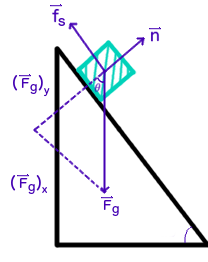Question #54360
1 Answer
I get answer A.
Explanation:
Here is a force diagram of the situation:

We can use this to come up with statements of the net force. Let's define up the ramp as the positive direction.
#sumF_"x"=f_s-F_"Gx"=ma_x#
#sumF_"y"=n-F_"Gy"=ma_y#
We know that there is no acceleration in the y-direction (the block does not move up or down relative to the surface of the ramp), so we have:
#n=F_"Gy"#
Using trigonometry, we see that the x-component of the gravitational force
#sin(theta)=(F_"Gx")/F_G#
#=>F_"Gx"=F_Gsin(theta)#
And similarly
Then we know that
#color(blue)(F_"Gx"=mgsin(theta))#
#color(blue)(F_"Gy"=mgcos(theta))#
Then:
#f_s-mgsin(theta)=ma_x#
Since we've established that there is no acceleration in the y-direction, all acceleration must be in the x-direction. We can solve for
#a_x=(f_s-mgsin(theta))/m#
We also know that
#a_x=(mu_smgcos(theta)-mgsin(theta))/m#
Then we can factor out an cancel
#a_x=(cancelm(mu_sgcos(theta)-gsin(theta)))/cancelm#
#=>a_x=mu_sgcos(theta)-gsin(theta)#
#=>color(blue)(a_x=g(mu_scos(theta)-sin(theta)))#
We are given:
#mu_s=1/sqrt3# #theta=30^o#
So we can now solve for
#a_x=(9.81"m"//"s"^2)(1/sqrt3cos(30^o)-sin(30^o))#
Where
#=>a_x=(9.81"m"//"s"^2)(1/sqrt3*sqrt3/2-1/2)#
#=>a_x=(9.81"m"//"s"^2)(1/2-1/2)#
#=>a_x=0" m"//"s"^2#

